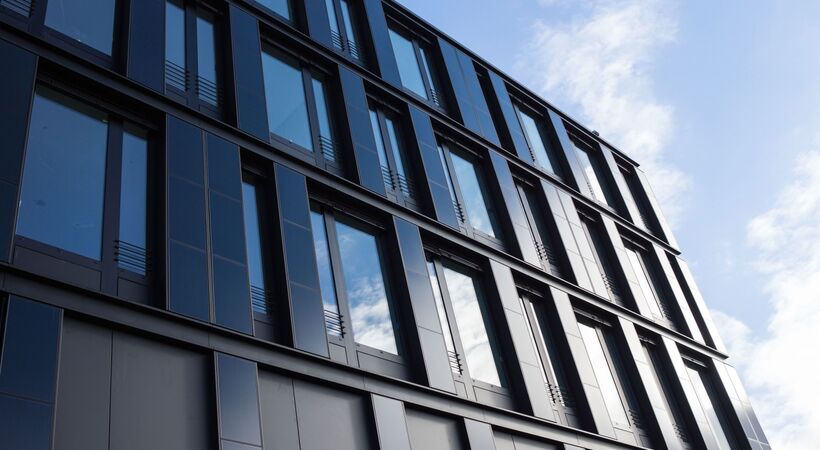Most photovoltaic modules in Germany are mounted on rooftops; very few are integrated into buildings' envelopes. The Centre for Solar Energy and Hydrogen Research Baden-Württemberg (ZSW) aims to change that with a research project it has been tasked to head up. Joining forces with fellow researchers and industry partners, the ZSW's scientists are setting out to optimize CIGS thin-film PV for facades. Well suited for integration into buildings, this technology has been a commercial success in rooftop and ground-mounted panels. Now a project is underway to bring to market building-mounted modules. Both manufacturing and system design issues are on the agenda of this project sponsored by the Federal Ministry for Economic Affairs and Energy (BMWi).
An EU directive requires all new buildings to be nearly zero-energy by the end of 2020. They will have to be built so that almost no extrinsic energy is required for heating, hot water, ventilation and cooling. Germany has also set its sights on a climate-friendly, carbon-neutral building sector by 2050. These goals will be hard to achieve without facades significantly contributing to the solar yield, which is why experts and scientists predict that architects and building planners will be making greater use of this technology. For German makers of thin-film modules and manufacturing systems, this is an opportunity to capitalize on an emerging mass market.
Helping BIPV break through
"In this research project, we're looking at the entire system of a thin-film photovoltaic facade," explains Dieter Geyer, project manager at ZSW. "We're optimizing the module's design for energy yield, shadow tolerance, installation ease, and flexibility in module size, and we're adapting it to the system's other components." ZSW researchers are investigating the electronic components' safety, functionality and reliability. They are also examining CIGS facades' energy efficiency potential to determine how the building itself can meet electrical power and thermal energy demands.
ZSW is performing the design calculations, conducting lab and field tests, and collecting operating data. Its researchers are assessing and comparing the different system's performance and yield in field tests on the CIGS facade at the institute's new building in Stuttgart and at the Widderstall testing facility. These operating data will be loaded to a simulation to help researchers determine to what extent CIGS facade systems can cover the demand for electrical power in different types of buildings. The project will also look at rear-ventilated, PV double facades and heat pumps. The designated partners aim to manufacture the optimized facade-mounted modules and system components when the project is concluded.
The ZSW's partners in this endeavor are the Research Centre for Sustainable Energy Technology at the Stuttgart University of Applied Sciences and Manz CIGS Technology. Associated partners include AVANCIS, Gartner Instruments, KACO new energy, SMA Solar Technology and SolarEdge Technologies.
Solar facades—more than merely a source of energy
Around three quarters of all photovoltaic systems are perched on rooftops; the other quarter is ground-mounted. Despite their great benefits, the number of building-integrated systems is infinitesimal by comparison. BIPV panels generate electrical energy, but they also afford much the same protection against wind and weather as conventional facades of similar quality. They insulate the building against noise, heat, cold and glare while allowing daylight to brighten the interior. The German Energy Saving Ordinance EnEV has acknowledged the merits of this application by awarding a higher DIN 18599 building class.
On top of all this, CIGS thin-film modules have aesthetic advantages that benefit facades. Unlike crystalline silicon PV cells, CIGS thin-film modules' cell structure is hardly discernible. This means the modules offer the same leeway as glass to facade designers, including homogeneous surfaces and elegant color choices. Variable module sizes, special shapes and structured surfaces are also available.
Studies have shown that the additional economically usable facade area for BIPV in cities amounts to around ten percent, on average, of the economically usable roof area. Many facades offer more space than rooftops, especially those on buildings higher than three stories. Integrated photovoltaic panels cost more than conventional rooftop modules. However, cost calculations merely have to factor in the markup on a conventional facade when a new envelope is being built. Such calculations show that solar facades can pay off within ten years.
Another interesting aspect is the higher value of electricity from facades, where production may peak in the morning or evening hours, depending on orientation. This offers an opportune alternative to the usual midday peak. And if a battery is to be installed for nighttime power, it can be smaller. In addition, vertically arrayed BIPV systems' are better positioned to capture the low winter's sun rays. They also have a great advantage over rooftop systems in snowy conditions, as they deliver a consistent yield and can increase the share of electricity consumed on site. All this adds up to a golden opportunity for an underused technology.
www.zsw-bw.de



